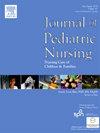The acceptability, feasibility and adoption of a co-designed electronic post-injury psychosocial screening tool for carers of children admitted to hospital following injury
IF 2.1
4区 医学
Q2 NURSING
Journal of Pediatric Nursing-Nursing Care of Children & Families
Pub Date : 2025-02-04
DOI:10.1016/j.pedn.2025.01.027
引用次数: 0
Abstract
Purpose
This study aimed to evaluate the feasibility, acceptability and adoption of a co-designed electronic post-injury psychosocial screening tool for carers of paediatric trauma patients.
Design and methods
A mixed methods approach with a parallel convergent design was used. The study occurred at a tertiary paediatric hospital in Australia, with data collected between April 2023 and February 2024. Data were collected through electronic surveys, semi-structured interviews, and the psychosocial screening tool. Participants included caregivers of hospitalised children and clinicians from the hospital's trauma service.
Results
Although both caregivers and clinicians found the tool feasible and acceptable, adoption rates were lower than expected. Key barriers included the tool's timing, which conflicted with caregivers' focus on physical recovery and emotional challenges discussing trauma. Clinicians viewed the tool as research-focused, limiting engagement. Logistical barriers, such as lack of clinician support and timing, further reduced adoption.
Conclusion
The tool showed potential for improving psychosocial support post-injury, but adoption was hindered by timing, emotional challenges and clinician engagement.
Practice implications
Clinicians must prioritise the acceptability, feasibility and adoption of tools when implementing caregiver support interventions for children with traumatic injuries. Future research should focus on overcoming implementation barriers and optimising psychosocial screening tools. Subsequent versions should align with caregivers' recovery timelines, embrace trauma-informed principles, promote clinician buy-in and be culturally tailored. Enhanced integration into clinical workflows and greater clinician engagement will boost adoption and effectiveness.
求助全文
约1分钟内获得全文
求助全文
来源期刊

Journal of Pediatric Nursing-Nursing Care of Children & Families
NURSING-PEDIATRICS
CiteScore
3.70
自引率
8.30%
发文量
291
审稿时长
65 days
期刊介绍:
Official Journal of the Society of Pediatric Nurses and the Pediatric Endocrinology Nursing Society (PENS)
The Journal of Pediatric Nursing: Nursing Care of Children and Families (JPN) is interested in publishing evidence-based practice, quality improvement, theory, and research papers on a variety of topics from US and international authors. JPN is the official journal of the Society of Pediatric Nurses and the Pediatric Endocrinology Nursing Society. Cecily L. Betz, PhD, RN, FAAN is the Founder and Editor in Chief.
Journal content covers the life span from birth to adolescence. Submissions should be pertinent to the nursing care needs of healthy and ill infants, children, and adolescents, addressing their biopsychosocial needs. JPN also features the following regular columns for which authors may submit brief papers: Hot Topics and Technology.
 求助内容:
求助内容: 应助结果提醒方式:
应助结果提醒方式:


